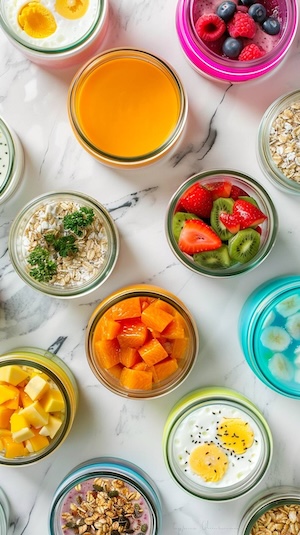PCOS for Picky Eaters: 30 Simple Meal Ideas
Discover 30 simple pcos meals for picky eaters that help manage symptoms. Easy pcos meals picky eaters will love, with practical tips and hormone-balancing ingredients.
Recipe by Art Smith When Chef Art Smith is cooking in his outdoor kitchen, all types of food can be found on his grill…even pizza! "I have great memories of spending time with people over pizza," Art says.
This recipe includes superfoods such as:
Transform your health with tailored 7-day meal plans designed specifically for PCOS management. Just $7/month or $59/year.
Get it now →1 c. warm water
2 tsp. active dry yeast
2 tsp. honey
1/2 c. extra-virgin olive oil
3 1/2 c. all-purpose flour or multigrain flour
1 pinch kosher salt
To make dough: In a food processor, combine the warm water, yeast, honey, and olive oil and mix well. Process until the yeast dissolves and the mixture is bubbly. Add the flour and pulse. Add a pinch of salt and pulse again. Run the food processor until the dough makes a ball.
Remove the dough, place it on a lightly floured surface, and knead for 2 minutes. Place the dough in a lightly greased bowl, cover well with plastic wrap, and refrigerate overnight.
Remove the dough from the refrigerator and divide into 4 equal pieces. Roll each piece needed into an 8- or 9-inch round. Tightly wrap the remaining pieces of pizza dough in plastic wrap and store in the refrigerator or freezer for future use.
To make sauce: Heat the olive oil in a medium saucepan over medium-low heat. When hot, add the onion and slowly saute; while stirring, 6 to 8 minutes. Add the garlic, red pepper flakes, and thyme and cook for another 6 minutes. In this recipe, we are not looking for color. Rather, we are slowly releasing the flavors of the ingredients by cooking them at a low temperature.
Add the brown sugar and stir until it is dissolved. Add the stewed tomatoes. Bring the sauce to a low simmer. Be sure to stir often enough so that the bottom does not scorch. Cook for 20 minutes.
Add the oregano, rosemary, and basil and cook for 6 to 8 minutes more, adding salt and pepper to taste. If the sauce's texture is too rustic for your taste, puree the mixture in a blender until it reaches the desired consistency.
To make pizza: Place a pizza stone in lower third of oven and preheat to 440 degrees. Roll out the dough on a lightly floured surface to a 9-inch round. Place on a lightly floured pizza peel or rimless baking sheet and top with the sauce, mozzarella, and basil.
Slide the pizza onto the hot stone and bake until crust is brown, about 20 minutes. Remove from oven and top with the prosciutto and arugula; season with pepper. Slice and serve immediately.

You know the drill: Alarm goes off. You hit snooze. Rush around frantically. Skip breakfast AGAIN because there's no time. By 10am, you're hangry, your blood sugar is all over the place, and your PCOS symptoms are already acting up.
Sound familiar?
Finally – a meal prep system designed specifically for women with PCOS who refuse to let chaotic mornings derail their health goals.
In just ONE hour on Sunday, you can transform your entire week:
"I went from skipping breakfast 4 days a week to having delicious, hormone-supporting meals ready every morning. My energy is more stable and my cravings have disappeared!"
– Sarah M.
Stop letting chaotic mornings control your health.
Get your hormone-happy mornings starting this Sunday.
→ Get Your 60-Minute Solution Now
Transform your health with tailored 7-day meal plans designed specifically for PCOS management. Just $7/month or $59/year.
Get it now →Serving Size: 1
| Amount Per ONE Serving | ||
|---|---|---|
| Calories 0 kcal | ||
| Fat 0 g | ||
| Carbohydrate 0 g | ||
| Protein 0 g | ||
💡 Introducing the 10/10 PCOS Solution:
Ten Delicious Crockpot Recipes that take just 10 minutes to prep!
Say goodbye to hours in the kitchen and hello to clean, PCOS-friendly meals made effortlessly.
👉 Click here to grab your 10/10 PCOS Solution today! Try The 10/10 PCOS Solution: Ten Crockpot Recipes That Take Just Ten Minutes to Prep
Managing PCOS can be challenging, but you don't have to do it alone. Join our supportive community to connect with others who understand what you're going through, share tips, and get encouragement. Here's how you can get involved:
Subscribe to our Newsletter: Receive PCOS-friendly recipes, tips, research updates, and more delivered straight to your inbox. Stay informed and empowered with the latest information and support.
Join our Telegram Channel: Stay updated with the latest tips and advice on managing PCOS.
Follow PCOS Meal Planner on Facebook: Engage with our community, participate in discussions, and get support from others.
Break the cycle with the PCOS Meal Planner - your personalized guide to eating better, feeling better, and managing PCOS symptoms. Take control today!

Forget the frustrating cycle of weight loss attempts, endless medications, and living in discomfort. Introducing the PCOS Meal Planner. A meal planning guide that goes beyond temporary fixes to offer a comprehensive strategy, empowering you to ignite a transformation towards lasting health and happiness. Step into a world where you control your PCOS, not the other way around.
Unlock Your PCOS Freedom Now.
Discover 30 simple pcos meals for picky eaters that help manage symptoms. Easy pcos meals picky eaters will love, with practical tips and hormone-balancing ingredients.
Discover 15 delicious overnight oats for PCOS recipes that help balance hormones and manage symptoms. Easy, nutritious breakfast ideas perfect for women with PCOS.
Discover the best cereal for PCOS with our expert rankings. Compare brands, check ingredients, and find PCOS friendly cereal that supports hormonal balance.
Learn how to transition away from fruit when starting a ketogenic diet for PCOS. Discover gradual strategies, fruit alternatives, and practical tips for success.
Discover 5 delicious PCOS banana bread recipes with low-glycemic ingredients. Learn how to make hormone-friendly banana bread that supports blood sugar balance.
Creatine for women with PCOS explained simply. Learn safety, benefits, hormone effects, tips, and how creatine may support PCOS symptoms naturally.
Complete PCOS diet plan with foods to eat, foods to avoid, meal timing, and real results. Learn the science-backed approach to managing PCOS through diet, with 7-day meal plan, grocery list, and step-by-step implementation guide. Based on clinical research and real patient outcomes.
Complete guide to ordering at Wendy's with PCOS. Discover the best protein-focused meals, what to skip, and how to customize orders to keep blood sugar stable. Learn which burgers, salads, and sides work for PCOS, plus complete macros for every menu item and smart swaps to avoid insulin spikes.
Complete guide to ordering at Burger King with PCOS. Discover the best protein-focused meals, what to skip, and how to customize orders to keep blood sugar stable. Learn which burgers, salads, and sides work for PCOS, plus complete macros for every menu item and smart swaps to avoid insulin spikes.